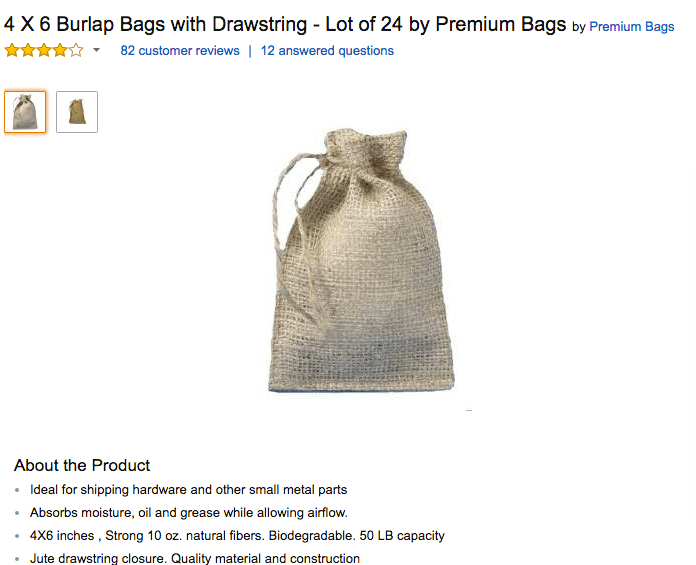Blog: The Million Dollar Case Study: How To Find Amazon Product Ideas
The Million Dollar Case Study: How To Find Amazon Product Ideas
They say that success is the sum of small efforts repeated day in and day out. This statement certainly applies to the success of Jungle Stix–simple bamboo marshmallow roasting sticks.
Who would have thought in December 2015 when we launched the product on Amazon as the product in the Collaborative Launch that the product would sell nearly $200k in just the first year? Greg Mercer did (though I think even he was pleasantly surprised by the volume of sales).
But if there is one person who would try to outperform an already impressive accomplishment, it's Greg. And of course he runs with a bit of swagger: one million dollars, to be precise!
Today Greg launched his Million Dollar Case Study: a step-by-step study in generating a million dollars in selling physical products. We will share every detail, financial figure, and strategy on our path to hitting seven figures. This makes for a medley of excitement, inspiration, and education. So let's get to it and review the first session of The Million Dollar Case Study!
Webinar Replay & Slides
Without further delay, here is the action-packed hour that we just covered to find some potential ideas for our Million Dollar product:
And here are the slides that Greg covered:
The easiest way to get to a million dollars is to layer on more products. Hence the search beginning now, for a new product that will take us to seven figures.
A Bit Of Background
We started selling Jungle Stix about 14 months ago, there has been over $210k in sales, and we have donated about $53k to Doctors Without Borders thus far.
Here are two different team pics with our donation checks, and a screenshot of the sales over 14 months:
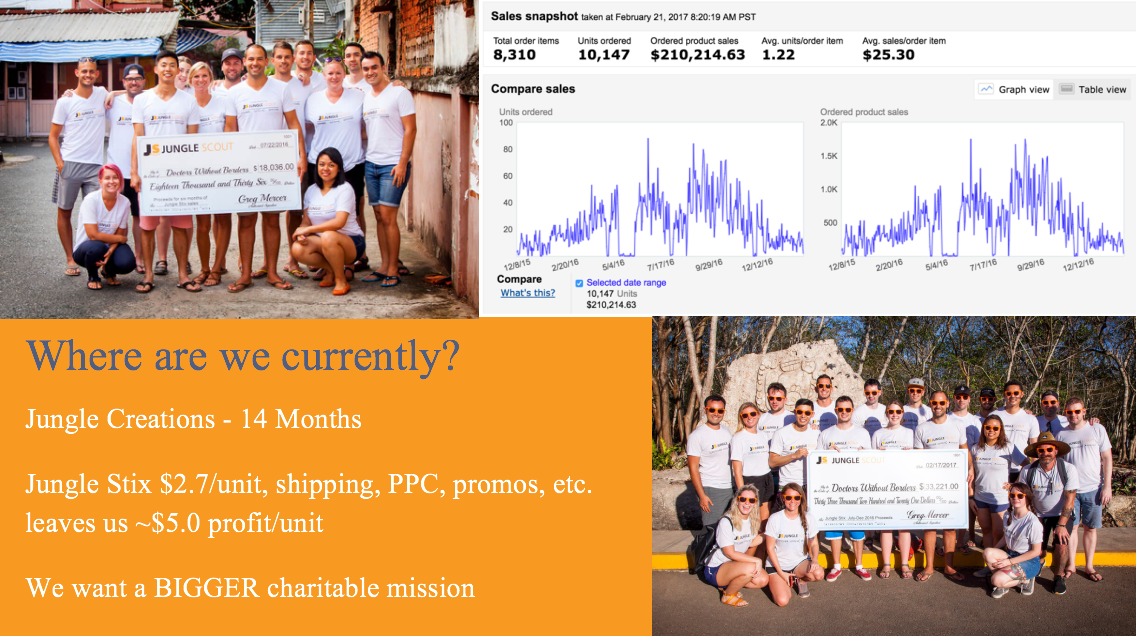
A summary of Jungle Stix:
- 10,147 units sold (as of yesterday)
- Average selling price: $25.30
- $2.7 cost per unit
- After Cost of Goods Sold, Shipping, Pay Per Click, promotions, etc, we are making $5.00 per unit
But we can go bigger! And that is the genesis of this million dollar case study!
Just In Time Learning
The general knowledge required, not to mention the intricacies of selling on Amazon, are enough to question your decisions before you even start finding a product. But that is not a reason to not sell on Amazon!
Enter the concept of “Just In Time Learning.” In short, don’t worry about the looming details down the road, but just follow along with us along each step of the process, and learn the necessities as we cover it in the case study. Trust us, if you have the drive, all you need to do is follow along, do your home work, and you will be well on your way.
In short, the process of selling on Amazon is a simple four steps:

Our Product Criteria
There is a certain level of faith in numbers that you need when doing product research. Though it may seem like a more fun and attractive option to sell a product that aligns with your passion, it is not always prudent. The best way to identify a product idea is to begin with a blank slate, and let existing customer demand guide your brainstorming process. Trust the process, as they say.
Another instinct we have to dispel is that we are not looking to sell new product ideas or invent new products. Success as an Amazon seller will come when you can identify what people are searching for on Amazon today.
If you can capture just a sliver of this existing demand with a solid product (hence you get good reviews and move up in the organic rankings), and a strong product listing (sharp product photos, thorough product descriptions with well-researched keywords) then you are setting yourself up for success. And that’s exactly what we want!
The Key Elements Of A Great Product Opportunity
Pay close attention to these criteria – as it will stop you from making a bad decision later down the line (read: an expensive mistake).
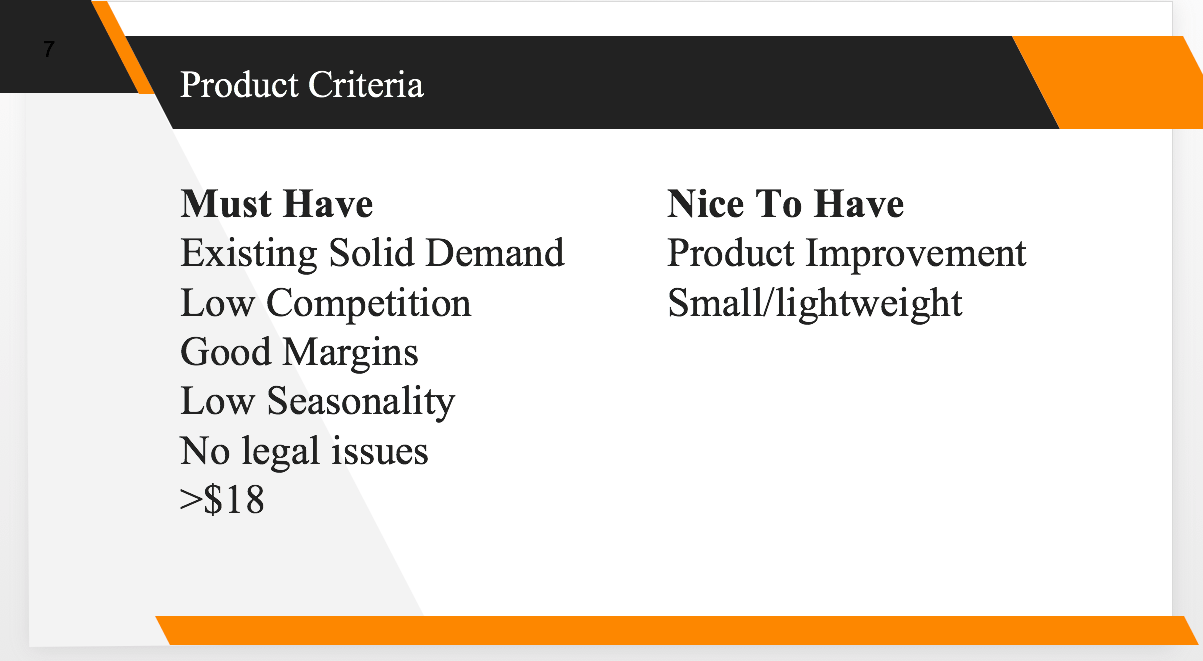
We are looking for:
- Low Seasonality – We want a product that will sell year round.
- No Legal Issues – Products that have licenses or trademark issues are to be avoided.
- Price Point greater than $18 – We will increase our ability to generate a million dollars in sales if we have a higher price point per unit. Greg has placed his floor at $18 during this research phase.
- Product Improvement – If we can sell a product that is better than the competition, then it improves our chances of generating more sales. We were able to do this with Jungle Stix, by selling a longer stick, and in greater quantity per package.
- Small and Lightweight – It reduces storage and shipping fees if a product is small and lightweight. At 36” in length, Jungle Stix did not meet this criteria, but there were other factors that offset this downside (mainly the significant demand with scant competition).
Building An Initial List of Product Ideas
Let's take a look at some of the powerful initial product research methods covered in the webinar.
How To Find A Monthly Sales Estimate
This is a quick aside to show you how you can get a product's estimated monthly sales. It's very simple.
First of all, find the Best Seller Rank for any product on Amazon (make sure you use the main category of the product). So for example, for this product, we take the Amazon Best Seller Rank (found in the Product Details section of the listing):
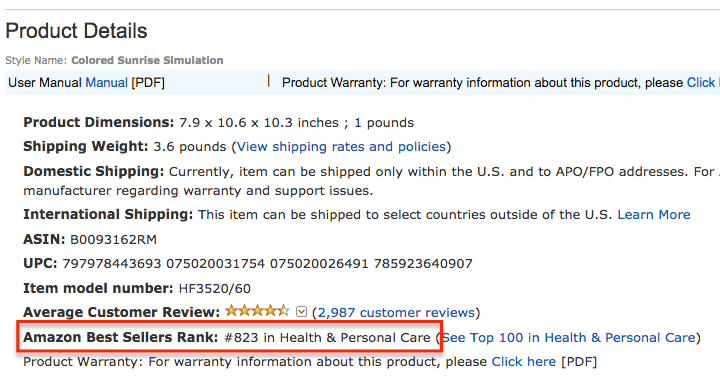
And enter the rank of #823 into Jungle Scout's free tool, the Sales Estimator:
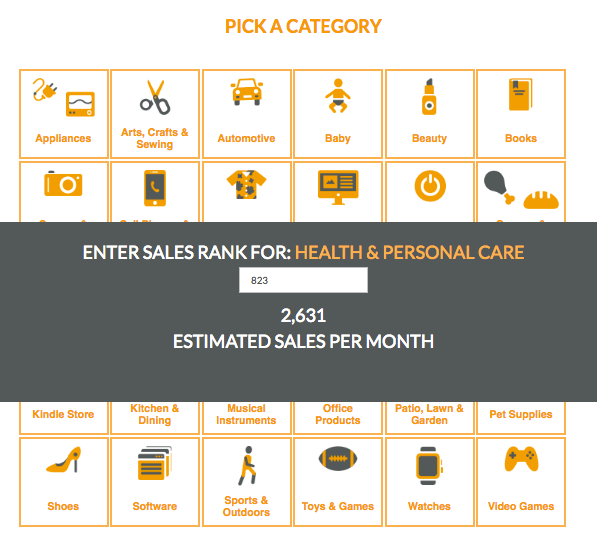
These are the same algorithms that we use in the Web App and Extension, so you can rest assured that these are the most accurate and up-to-date sales estimates around ;-).
Product Categories to Ignore
For private label sellers, not all products are created equal. There are complex products, like Appliances, Camera & Photo, Cell Phones and Accessories which are better to avoid for various reasons. Mainly, complications with manufacturing and shipping make it a looming headache with quality assurance, customer reviews/returns, and liabilities. Additionally, anything that goes “on” or “in” your body – lotions, foods, nutritional supplements, are laden with potential liabilities.
Categories such as clothing and shoes are ones to watch too. Most people have brand preferences when it comes to clothing, so creating your own brand is less likely to succeed here.
Leveraging The Web App to Generate Ideas
There are infinite ways to find product ideas (like browsing through Amazon Best Sellers, eBay, Alibaba, Reddit, or even our own list of over 1000 high potential niches).
But for simplicity's sake, we are using the fastest proven method we know: Jungle Scout's Web App. It is a catalogue of Amazon's best selling products, organized by the data that we as Amazon sellers care about: monthly sales, price, Best Seller Rank, Rating, number of reviews, and much more.
To start, we filter with the following criteria:
- Price – greater than $20.
- Estimated Sales – greater than 400 per month. This ensures that the product sells well.
- Reviews – under 100, thus a relatively new product without a long history of customer reviews. This means that we could compete with the same product in a short amount of time.
- Rating – under 4.2 so that there’s room for improvement to create a differentiated product.
- Product Tier – Standard, so that it will be a smaller product, so we can make inventory management easier
The Jungle Scout Web App filter that we used to find our initial product ideas ultimately looked like this:
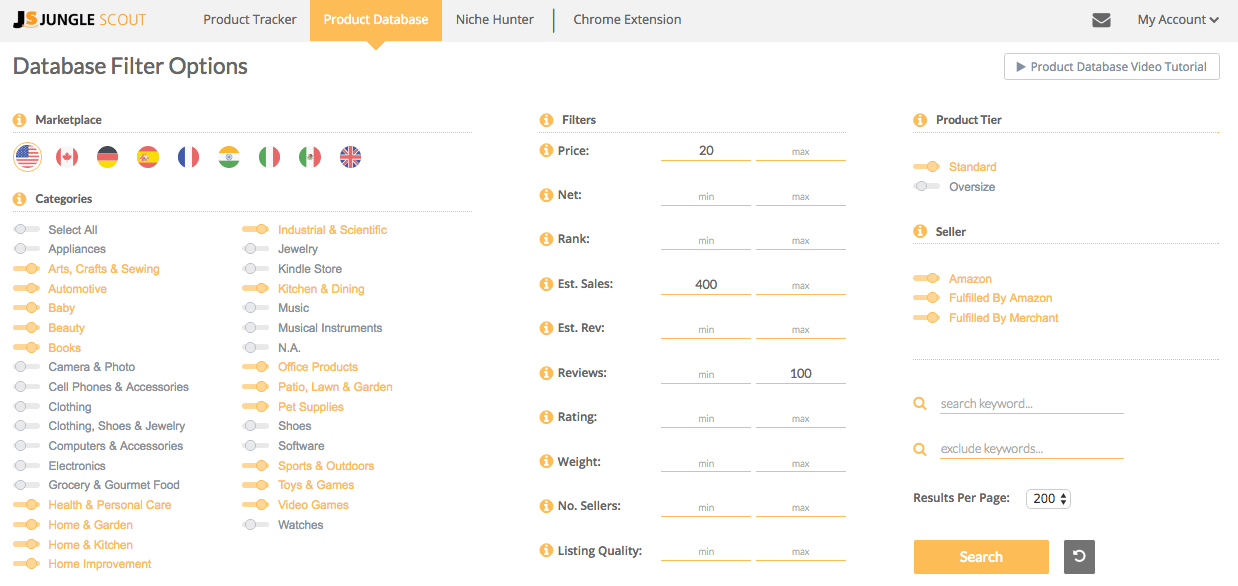
We started with 20 million products in the initial Product Database, and after the criteria filter it got whittled down to 2100 products.
From this curated list of products, we have products that sell at a rapid clip (more than 400 per a month), yet still belong to relatively new niches and are not too competitive.
Additional things that we avoided when searching through these resulting products:
- Avoiding clothing brands and licensed products.
- Avoid any potential liabilities
- Don’t want anything that will break easily, including anything that is glass or electronics
- Water filters, which may have quality control issues
- Things that don’t work, so you can avoid bad reviews (like plastic bags that help you lose weight!)
And things that we were looking out for:
- Relatively simple without quality control issues when getting produced
- Weird products – those tend to be strange, obscure, and not often sold by others on Amazon
- Easy to find a good factory – for example knives may be hard to find a quality manufacturer
1. Our First Find – Burlap Bag
The first product that met the criteria was a burlap bag:
It met the basic criteria, around $20, 400 sales per month, and opportunity for improvement. But is it a good niche overall?
To answer this question, we pulled up the main keyword, “burlap bag small” in Amazon, and examined the data that Jungle Scout Extension showed on the niche. The Extension is an excellent tool to evaluate a keyword and niche as a whole.
The results on Amazon look like this:
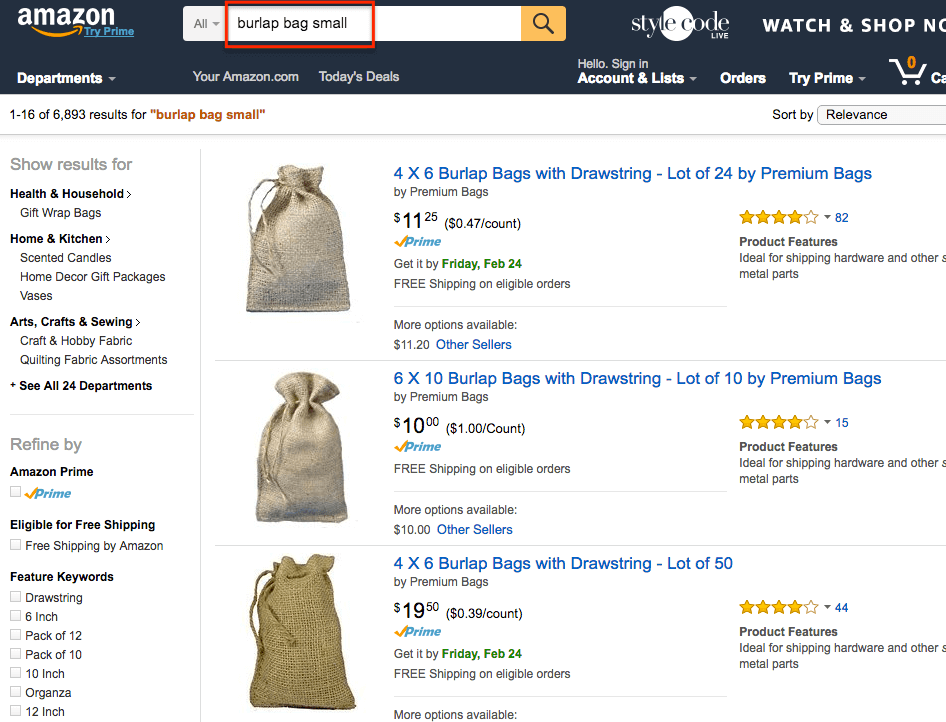
And the resulting Jungle Scout data looks like this:
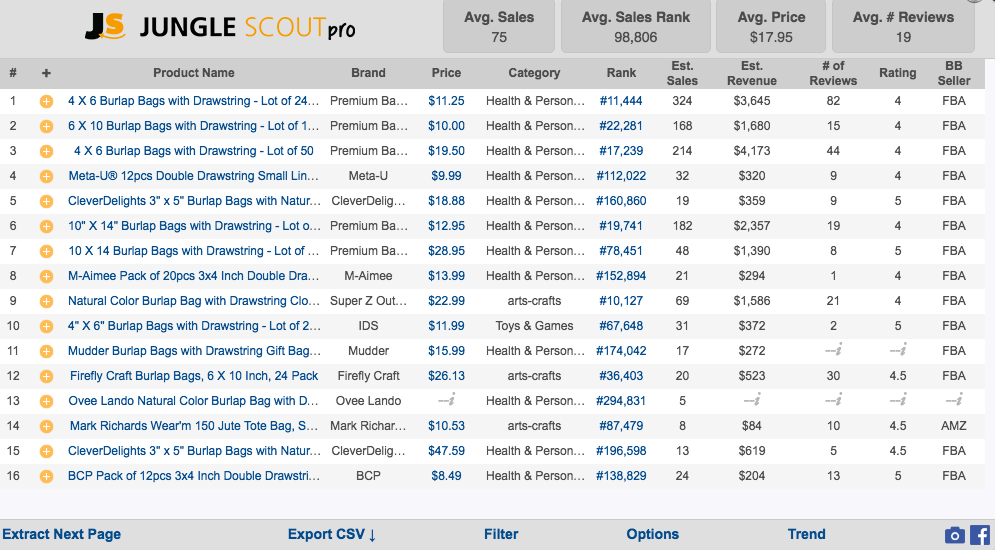
Unfortunately, the bags look to be priced too low, generally around $12.
The top reviewed listing sells well at 320 estimated sales, which is decent. However, the top 10 sellers for this product are not all selling this well. There are about 1000 sales for the top 10 sellers, which indicates a lower demand. Greg likes to see 2000 sales, so twice as much demand.
The positive part here, is that there is low competition if we look at the number of reviews that this product has. So we could probably rank in the top organic results for “burlap bag” relatively quickly. But the sales would be scant. Who really wants to be the ruler of a deserted island? Not us, at least for the purposes of this case study!
2. Tactical Belt
The second product that we investigated was a tactical belt, which looks like this:
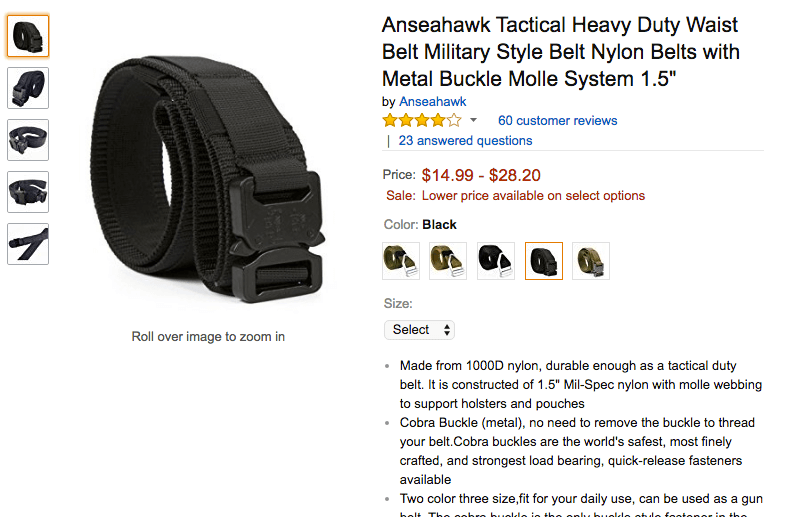
And the Jungle Scout results for the top ranking products for “tactical belt”:
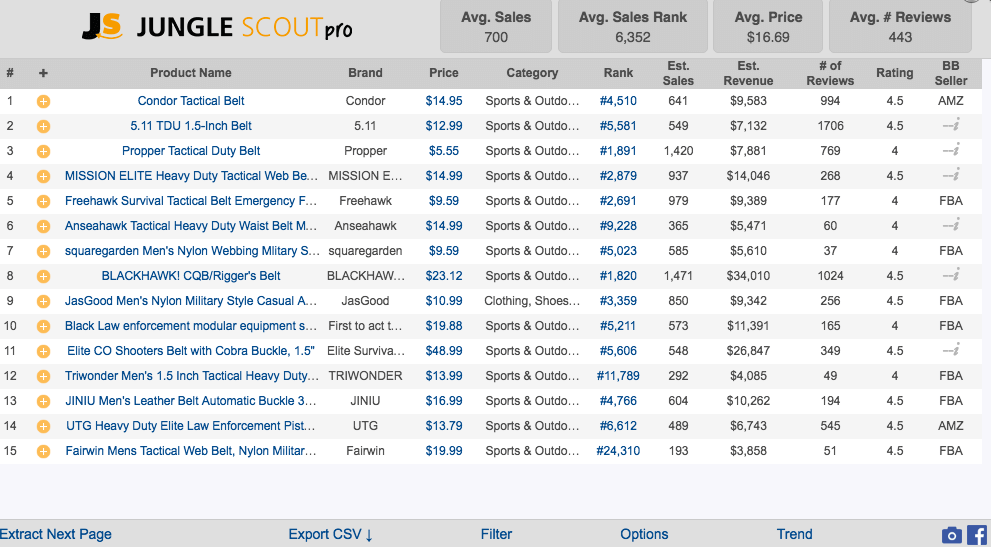
The demand for these belts is definitely there, with all of the top 10 sellers moving more than 400 units per month. However, it is also relatively competitive, as only one seller in the top 10 (the 7th ranked product) has less than 50 reviews.
Prohibitively competitive? Probably.
There is potentially ways to niche down, for example focusing on a particular color, or purpose (Air soft, military, paint ball, etc). However, again, we may just move on…
3. Baby Hooded Towel
The third, and last product that we examined in the webinar was a baby hooded towel. Basically, a soft towel with a hood to keep the baby warm after a bath. I have one of these (for my daughter), but wouldn't mind using it myself if I had one in my size! It looks something like this:
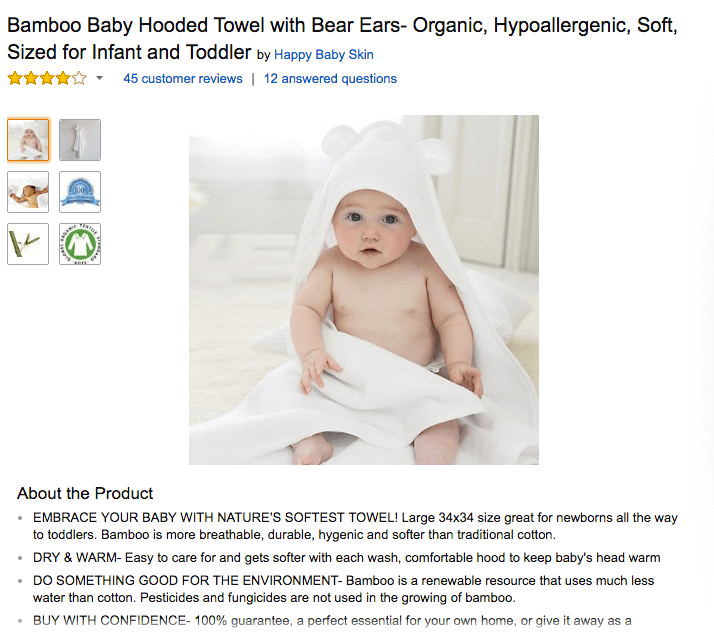
Looking at the Jungle Scout Extension results, the average product sells for $18, has significant demand (the top 10 sellers far exceed 2000 sales per month), and there are some sellers that have under 50 reviews. So there is still room to enter this niche and rank quickly in the top 10:
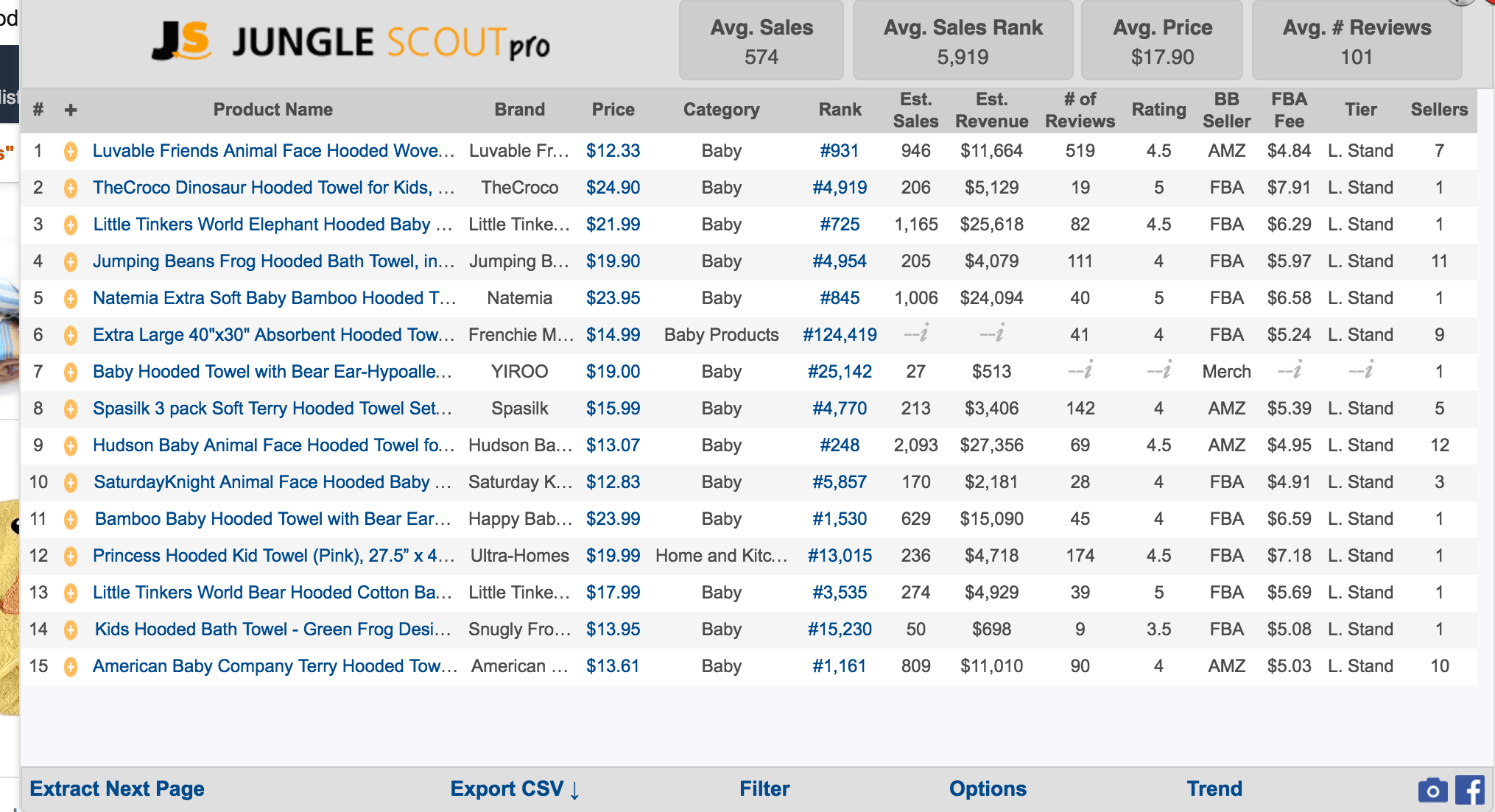
Awesome! Now the question is, can we make a profit on every sale if we sell this product? Let's assume we sell a higher-priced product, maybe $24 like some of the other options. The Amazon FBA fees are around $7, and assume $7 for product costs and shipping, that would be $10 profit per unit. All hypothetical still, but promising!
If we were to go forward with this, how would we position our product? To answer this, it is helpful to sift through some of the customer reviews that were critical of the products, to learn where product improvements could be made. Here are a few examples for various baby hooded towels:
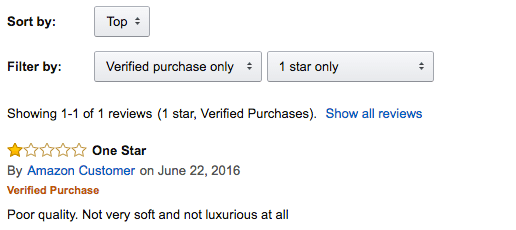
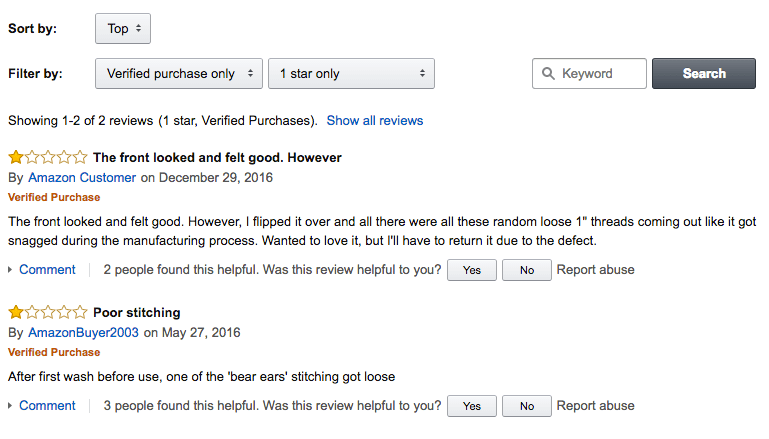
In short, the material has room for improvement, and quality of product overall was poor (threads coming out already and poor stitching). These could be improved with some special requests to the manufacturer.
Now let's take a look at the historical and seasonal trends of “baby hooded towels”.
You can pull the Google Trends for this keyword directly from the Jungle Scout Extension. The results look like this:

There is a slight uptick in searches since 2011, and the zig-zaggy pattern of the trends indicates some overall seasonality. However, it is not a feast-or-famine seasonality, which is what we want to avoid.
The overall assessment is that it is a decent product. However, the search will continue!
Additional Filters – Dig Into The Data
Before breaking for the week, Greg shared a few more strategies for uncovering good products.
Find products with poor ratings
One filter is finding products that sell well, yet have a poor rating (i.e. under 3.2). Also known as the “how the heck do they sell so well with a crap product?” filter. It looks like this in the Web App:
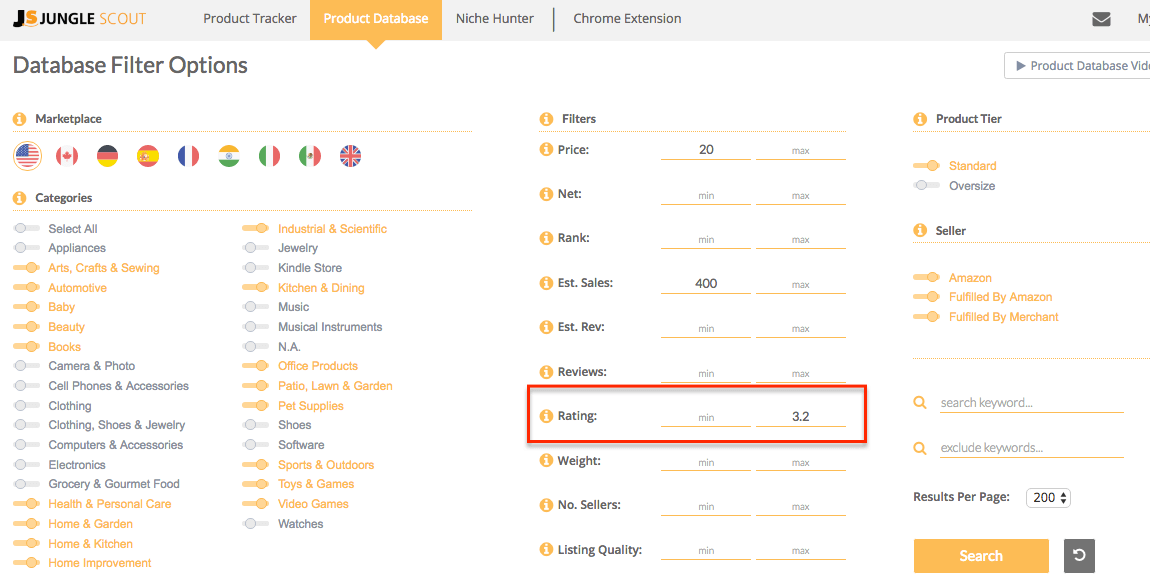
These are products that can be easily improved by reading bad reviews. Presumably, if we worked with a manufacturer to address the existing shortcomings, and used that to differentiate in marketing, it would be a great opportunity for us. Smart thinking!
Products that sell well have a poor listing
This filter identifies products that sell well, despite having a poor listing. The Web App filter looks like this:
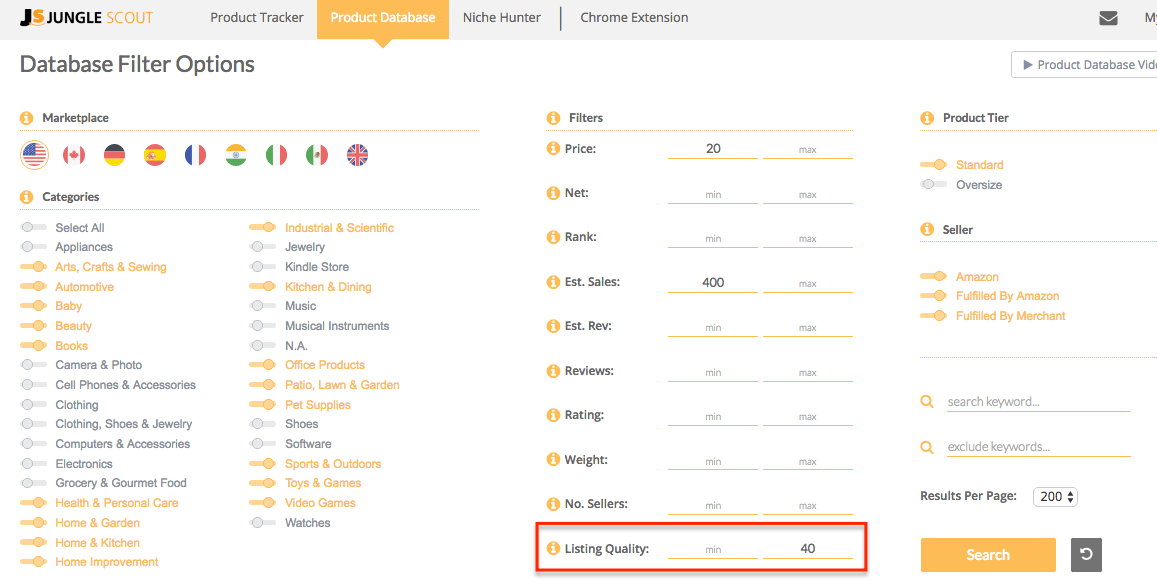
The Listing Quality Score is a proprietary Jungle Scout rating that analyzes the strength of a rating, including quantity and quality of product images, Product Title, Product Features, Product Description, and more.
To visualize this, take a look at the Jungle Stix listing, which has sharp product images, a well structured Product Title with lots of relevant keywords, and clear product benefits:
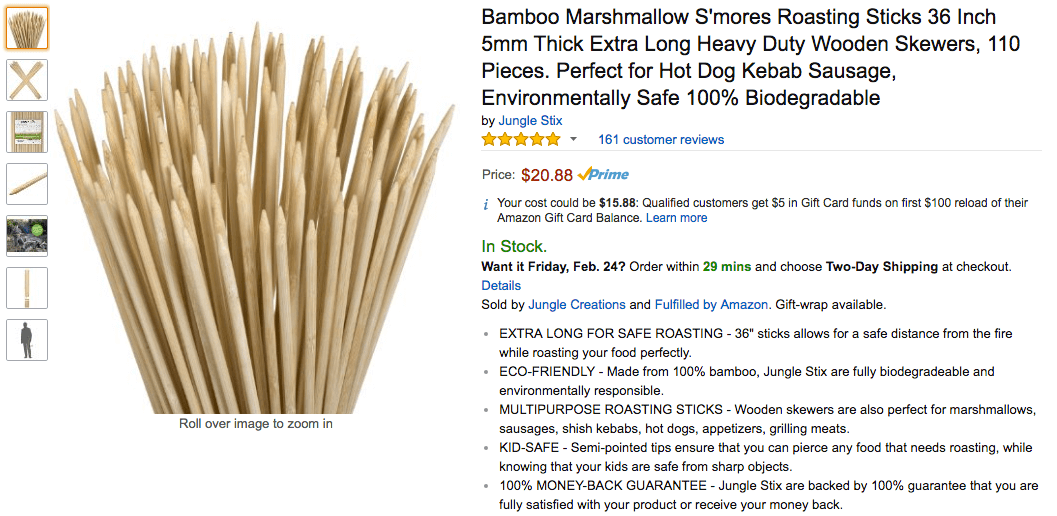
In contrast, this listing is a random one that popped up in the Web App with a poor Listing Quality Score:
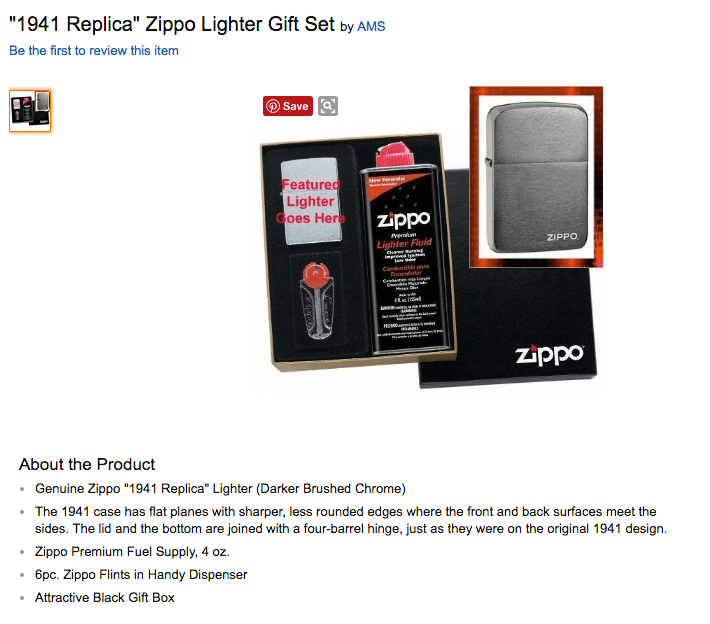
The difference is self-evident. Yet this product could be selling incredibly well, even though it is doing no favors for itself. If you could beef up the listing with more keywords, better pictures, and actually convince more people to click on the listing and purchase, that would be money in the bank! Funds to charity! A winner indeed.
So that's a good way to find additional product ideas.
Next Steps Until Next Time
So that's a wrap for this week. In the meantime, Greg is going to continue using the methods outlined above to find more product ideas, and re-evaluate where there may be opportunities.
At this point, it is just about creating a lengthy list of potential ideas, and points of differentiation or improvement.
Follow the next steps in session #2 which we held on Wednesday, March 1st. If you missed it or need to rewatch, you can catch the recap, replay and slides here.
Let us know how you are getting on with your own product research journey in the comments below. Looking forward to working through this journey with you!

